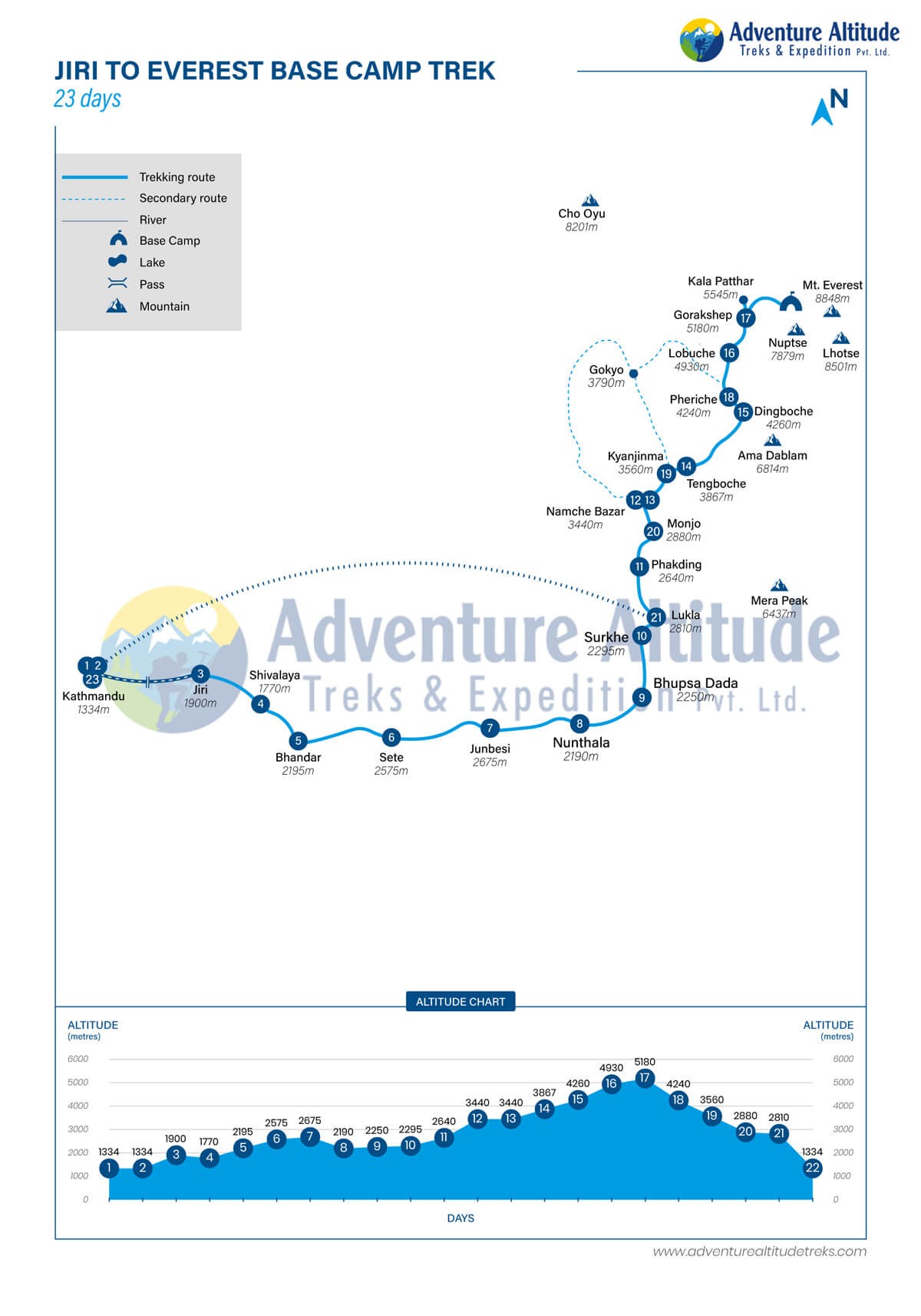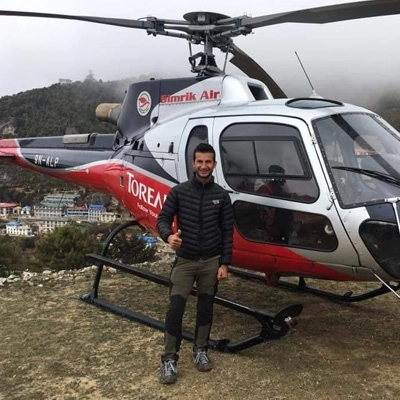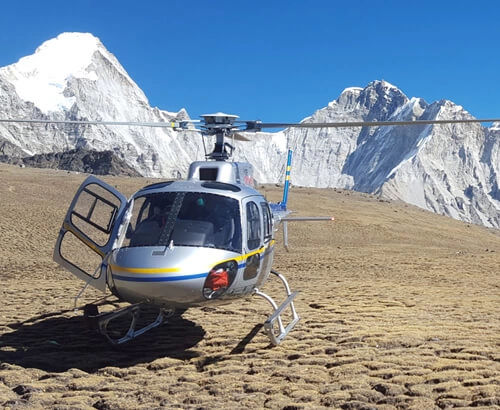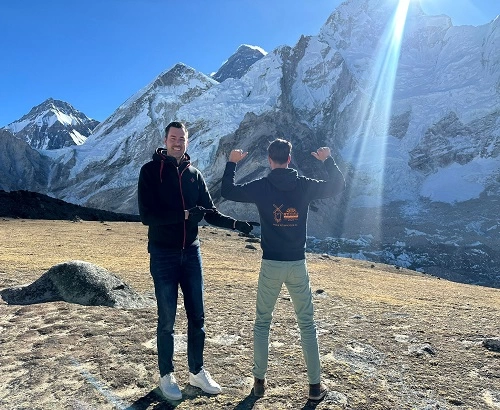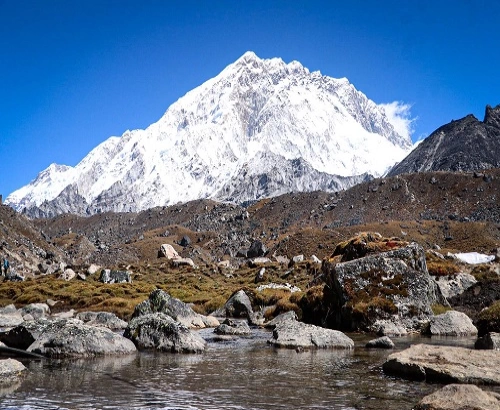The difficulty of Jiri to Everest Base Camp Trek.
As we all know, high-altitude trekking is never easy. But the Jiri to Everest Base Camp trek demands really good physical fitness and long holidays. Since we are trekking 5-6 hours a day through many ascents and descents, stamina, endurance, and agility matter. A month of physical fitness exercise has proven useful to do this trek.
Jiri to Everest Base Camp Trek involves a tremendous amount of up-and-down walking. All the rivers in this part of Nepal flow south from Himalayan glaciers, but the trek route proceeds east. Therefore the track must climb to the ridge that separates two rivers, descend to the river itself, and ascend the next ridge. Even though the trek begins at an elevation of 1860m, on the sixth day it crosses the Dudh Koshi at only 1500m – after considerable uphill (and downhill) walking. So the trail of Jiri to Everest Base Camp trek is graded as strenuous.
But, with us, no beginners should worry. We will customize the itinerary according to your ability. We can add resting places in between an acclimatization point also. We can extend days so the beginner can complete this strenuous trail safely and successfully.
Lifestyle and Culture in Jiri- Everest Base Camp trek region:
Jiri to Everest Base Camp trek is one of the most fabulous trekking routes in the Khumbu region. This is the classic Everest Base Camp trek route which is also called Hillary Trail as Tenzing Norgay and Edmund Hillary trekked through this trail to summit Mount Everest. The region is mostly inhabited by Local Sherpa people with Buddhist and Bon religions and mixed Tibetan-Nepalese culture. The main festival of this region is Lohar. Every single day of hiking allows you to explore different aspects of the region from flora and fauna to landscapes, farms to forests, warm to cool weather, etc. The trek starts from Jiri which means your body will get acclimatized accordingly while you trek. So there's no need for an extra acclimatization day. The trail is relatively less crowded as most of the trekkers prefer Lukla as a starting point so it will be peaceful and calm. Locals rely on farming as the main source of food and income during the off-season.
Guides and Porters
Adventure Altitude Treks is a government-registered trekking company. We provide you with the best guides for your utmost satisfaction regarding services. Though this trek can be done without guides and porters we highly recommend you hire a guide and a porter. This makes your trip more knowledgeable and easy. The time for searching for accommodations, and learning about places of interest, culture, and lifestyles on your own is completely saved which means you can enjoy your extra time chilling out with fellow trekkers, hiking around the places, etc. Since this is a strenuous trek, you want to carry as little as possible with you. So hiring a porter is highly recommended. A poster is provided for every two trekkers. The max load a porter can carry is 30 kg which divides into 15 kg per trekker. You only have to carry your backpack which not only saves energy for such a long and strenuous trek but also gives you enough time to enjoy the scenery.
Accommodations and Foods in Jiri - Everest Base Camp Trek
Accommodations: The accommodations for Jiri to Everest Base Camp trek are teahouses. A teahouse is a combination of a guest house and a restaurant. Most of the rooms of tea houses are equipped with twin beds which means most of the trekking part will be on sharing basis. The bedrooms are fairly basic equipped with twin beds and minimal furniture. The living room is devoid of any electric sockets for charging pieces of equipment unless the village has hydroelectric power. Teahouses in the upper region lack any sort of hydroelectric power and completely rely on solar power. Bedrooms may not have any lighting but the dining room is powered with solar energy where you can charge your small electric appliances for a minimal amount. The dining hall is a large common area fitted with a Bukhara stove to keep the area warm.
Foods: Chinese, Continental, Indian, Nepali, and Italian cuisines are found along the way. We recommend our guests avoid any meat supplements in the higher regions as they may not be fresh. It takes weeks to supply food to the upper region so the meat items may not be fresh and may result in food poisoning. Breakfast is mostly Tibetian style with huge Tibetan bread and tea. Dinner is mostly Nepali cuisine but you can find other options too. Chinese foods like noodles, thukpa, and momos are available in most tea houses. But Italian cuisines are mostly confined to Pizzas, burgers, pasta, and spaghetti. But the most preferred dinner is typical Nepali cuisine which is Dal Bhat. Dal Bhat includes boiled rice, lentils, curry, and pickles.
Our recommendation: Dal Bhat for dinner. Veg snacks for lunch and traditional Tibetan breakfast.
Best time to do Jiri - Everest Base Camp Trek
Two seasons are best for Jiri - Everest Base Camp Trek. The Spring season ( March to May ) provides trekkers with comforting greenery throughout the whole trail. The beautiful rhododendron forests covered with their flowers, green and serene coniferous forests, and landscapes covered with snow are the main features of this trail during the Spring season. The weather is super fine and stable with far visibility. The occasional rain clears up the clouds from the sky. The temperature in the lower region might be a little bit warm but higher up, it is still cold and can reach up to -10 degree Celsius at night.
Another best season for doing the Jiri - Everest Base Camp trek is during Autumn or Fall ( September to November ): If you hate warmer climates and want a different experience than the green forests, Autumn is the perfect season. The temperature is comparatively colder than in the Spring season but the weather is amazing. Clear blue skies and beautiful sunny days make this trail a fun adventure.
Acclimatization and Altitude Sickness:
Altitude sickness is always a risk factor in high-altitude trekking. The oxygen concentration level in the atmosphere decreases along with the increase in altitude. The higher you go, the harder you find it to breathe. There are certain ways to decrease the risk of suffering from altitude sickness. To minimize the risk, the following points should be kept in mind:
Trek at a slow pace, never hurry
Take acetazolamide tablets in case of emergency
Avoid using sleeping pills or any type of medications that slows down proper physical and mental functions in high altitude
Avoid heavy consumption of alcohol
Take some sips of water frequently to prevent dehydration
Stick to the traditional local cuisine as they are fresh. Foods like meats, bread, etc might not be fresh in upper regions so better consume freshly prepared local foods.
Plan your trip in such a way that you have acclimatization points in the proper place.
Always follow the ' Trek High, sleep low ' rule. This means avoiding sleeping at a higher altitude if you have options at a lower altitude.
It’s hard to predict exactly how your body will react to high altitudes because everyone is different. Your best defense against altitude sickness is not to climb too high too fast and to be prepared by practicing the tips above. If you have any existing medical conditions, like heart problems, trouble breathing, or diabetes, you should talk to your doctor before traveling at a high altitude. These conditions may lead to additional complications if you get altitude sickness.
So to avoid those risks and make the trek accessible for anyone, we, Adventure Altitude Treks have prepared the best itinerary with acclimatization points at different places. This helps your body accustomed to a new climate and altitude.

